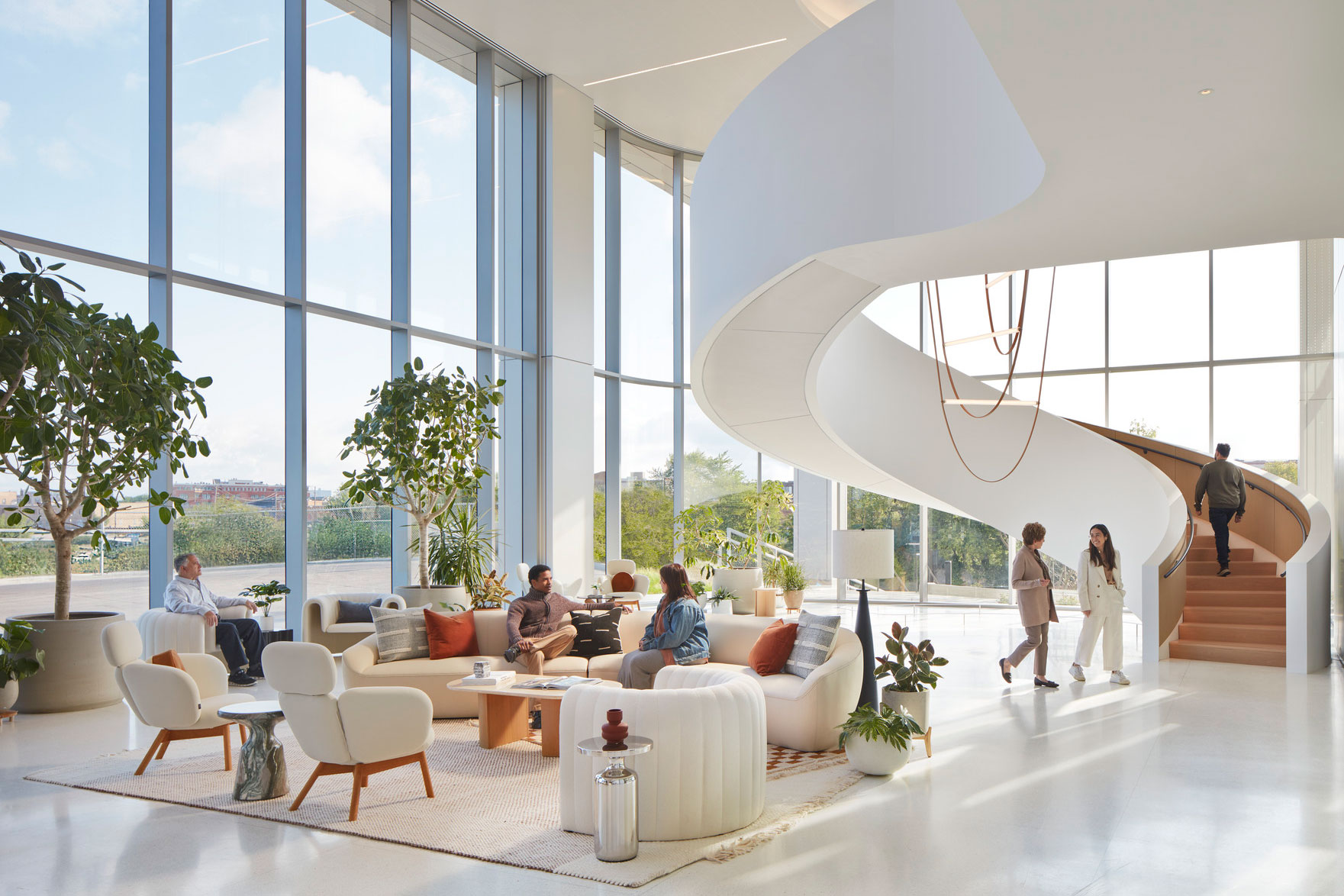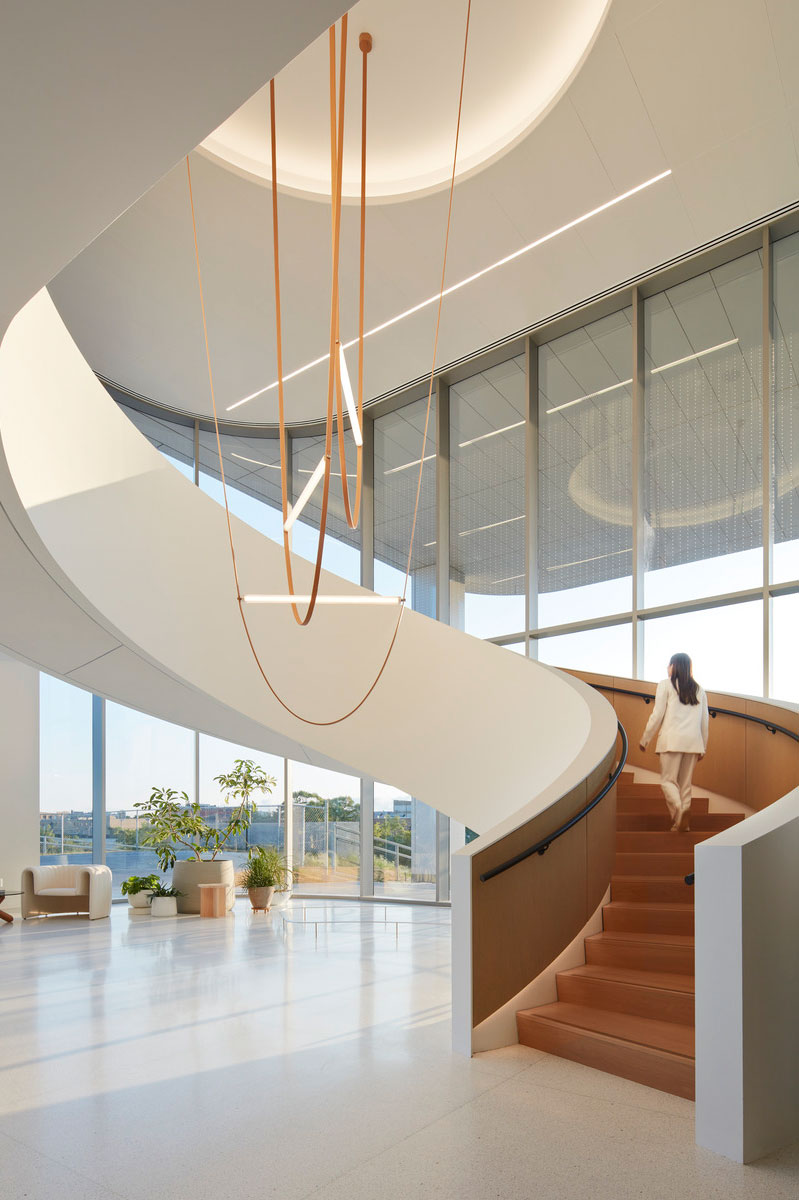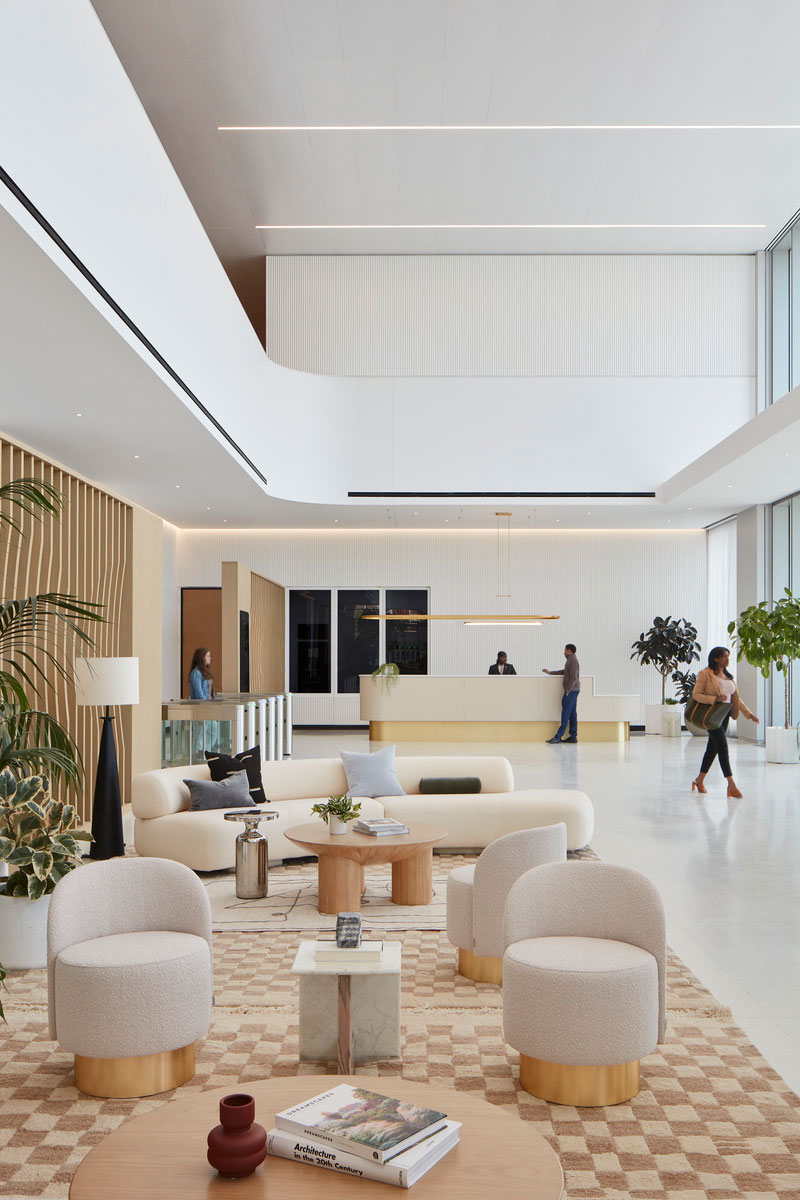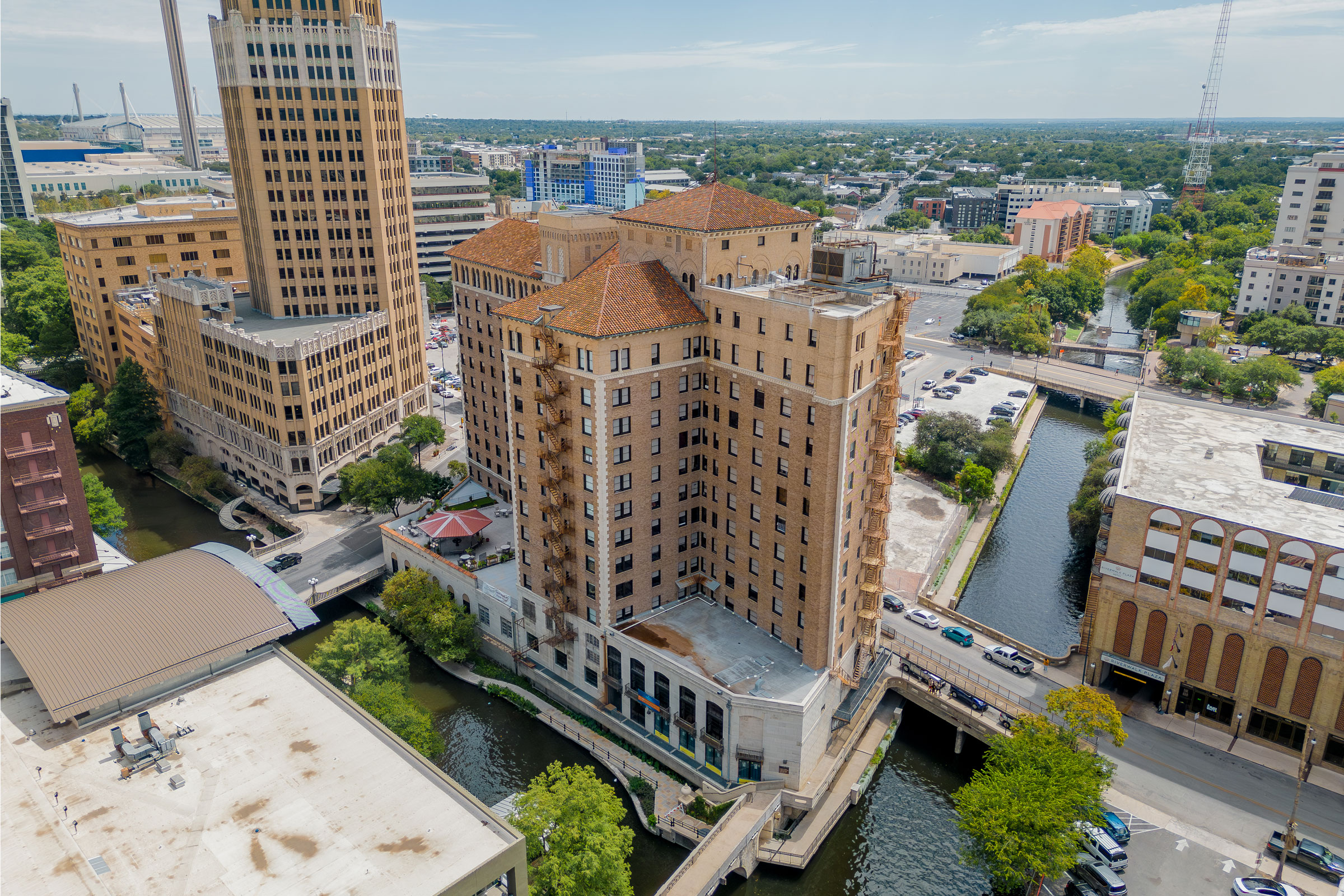Story at a glance:
- Lincoln Yards’ first major project, 1229 W Concord, recently opened on the Chicago River.
- Bird-friendly glass, expansive balconies, and a sculptural staircase reveal a commitment to beauty and sustainability.
- The design team at Gensler brought the feeling of hospitality to the life sciences project.
An eight-story building overlooking the recently revitalized Chicago River sets the tone for Lincoln Yards—Sterling Bay’s new 53-acre mixed-use community in a once heavy industrial area of Chicago. The project at 1229 W Concord encompasses 285,000 square feet and is leasing for life sciences companies.
The building’s relationship to the river was critical to its design, according to Gensler Principal Michael Townsend. “This project is the first picture of what this area could look like in the future and the community’s connection to the river,” he says.
As a life science building, he says it emphasizes Chicago’s commitment to the industry. “It’s saying, ‘Hey, we want to make an investment in life science. We see a lot of great potential for life science in Chicago, and we think a lot of that could happen at Lincoln Yards.”
Inspiring Interiors
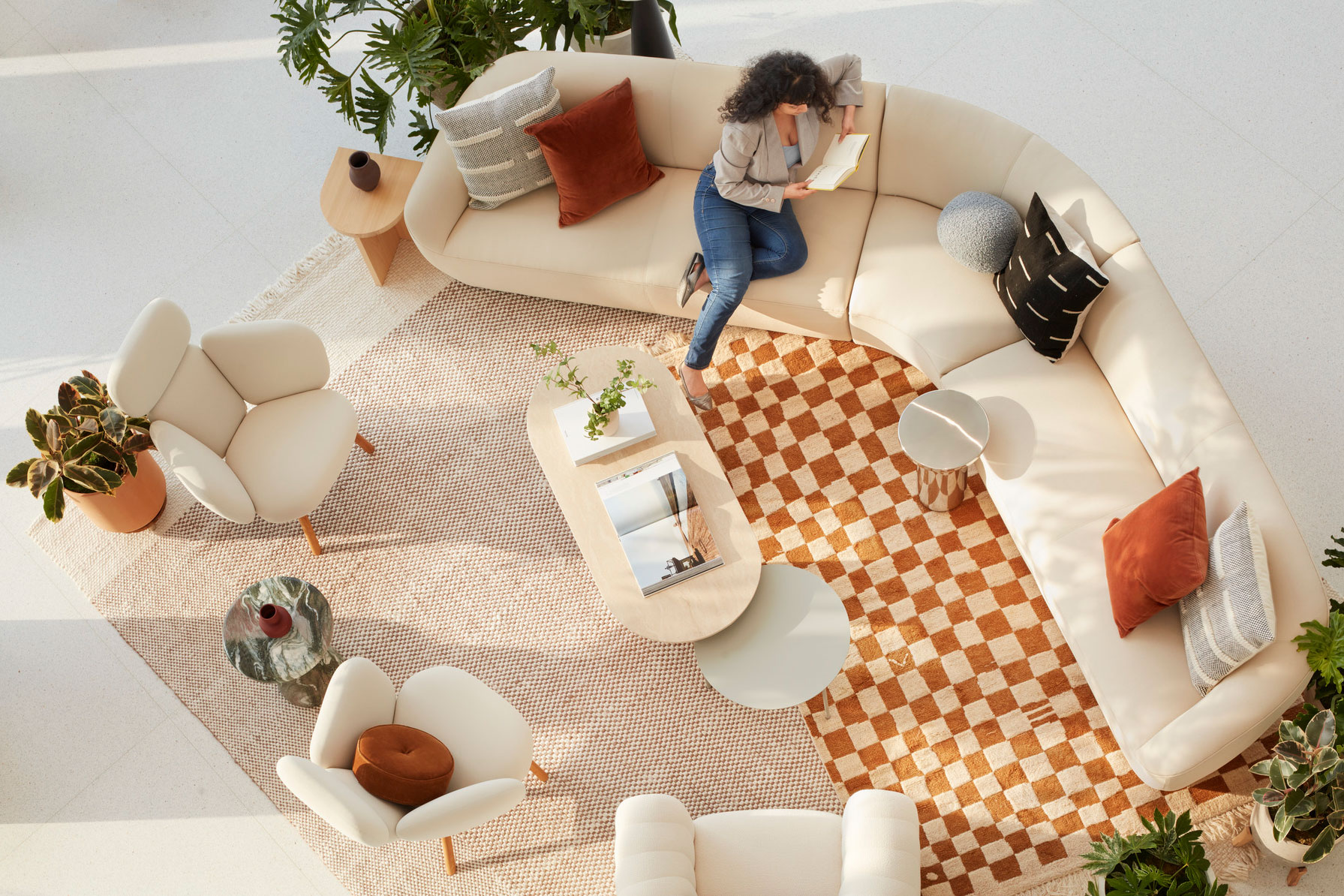
Lori Mukoyama, the design principal at Gensler who led the interior design at 1229 W Concord, says the team mixed and matched bespoke furniture, layered rugs, and plants. “We’re not doing one vendor anymore. We’re definitely having more fun with it.” Photo by Kendall McCaugherty
To be clear, this is not your average life science building. For starters, while its exterior is dominated by glass, that glass is bird-friendly. Access to nature and a sense of openness abound, as balconies give people up-close access to the outdoors while city views are abundant. Inside, the interiors are inviting. A warm, neutral color palette draws you in, and public spaces are designed with cozy furniture, wood detailing, lamps, plants, rugs, and other aspects to make public spaces feel more like home.
It’s all inspired by the nature around the building, says Lori Mukoyama, the design principal at Gensler who led the project’s interior design. She and Townsend both have a hospitality background and said part of this building’s mission was to think differently about what people need—especially post-Covid.
A wood wall in the interior is a perfect example of doing things differently. Rather than a perhaps more expected glass wall—giving the feeling of airport security—Gensler thought, why not design something that feels more at home in hospitality? “I don’t want to go to work feeling like I’m going through a terminal every day,” Mukoyama says. “So we created a wood screen that has beautiful DNA. If you look at it from the side, it looks like it has a helix going through it, and then a bookshelf as well.” It offers security and separation, but it’s also aesthetically pleasing and multipurpose.
The design team wanted the interiors to feel like a continuation from outdoors—from water and nature to wood and glass. An enormous white circular staircase conjures the wind as it carries people to the second floor. The color palette reflects the greens and ombre tones of foliage, rugs are layered to provide a feeling of warmth, and woods are pulled from native species. “We’re trying to bring that whole experience inside the space,” Mukoyama says.
Much of the design was informed, perhaps surprisingly, by the sanatoriums of the 1800s and 1900s. While there may have been no cure for tuberculosis, the experts of the time knew access to fresh air and daylight made people feel better. “At the time buildings and architecture were not providing those things. It was a full building movement and the bones of what we think of as modern architecture today,” Townsend says. “If you look back at some of the sanatoriums of the time, you’ll see the direct inspiration we took from those in this building—with these long horizontal balconies and ample levels of daylight in the space, floor to ceiling glass, color palettes, and things like that.”
Light & Air
- A dramatic spiral stair connects the first and second floors and is a nod to the DNA helix. Photo by Kendall McCaugherty
- To the left, a wood screen provides privacy and separation while acting as a bookshelf. Photo by Kendall McCaugherty
Those principles of light, air, and openness drove much of the project’s design, as those elements were top of mind when this project started and the design team was largely working from home. “We were all talking about the value of fresh air and access to outdoors and daylight. Those are the principles for a great building and environment for the people inside,” Townsend says.
It’s a really beautiful art piece and a nod to the ingenuity and the thinking behind life sciences.
Mukoyama says the lighting strategy was especially important, as it wasn’t all direct. When you think of a lab you may think of harsh lighting, and the team took great care to ensure that wasn’t the case here. “We wanted to take advantage of the architecture and the glass, taking advantage of full height space. Michael and his team were really conscious to carve out a tall lobby space. Everyone has access to that lobby, so then you give everybody the opportunity to have that nature and that closeness to natural daylighting.”
In the middle of the stairway—itself a work of art in the corner of the lobby—a stunning light fixture hangs, furthering the idea of the helix and adding more soft lighting. “We have a lot of soft cove lighting and indirect lighting. There’s a really beautiful glow. You feel very warm and comfortable, and it’s also very peaceful,” Mukoyama says.
Unlikely Pairs
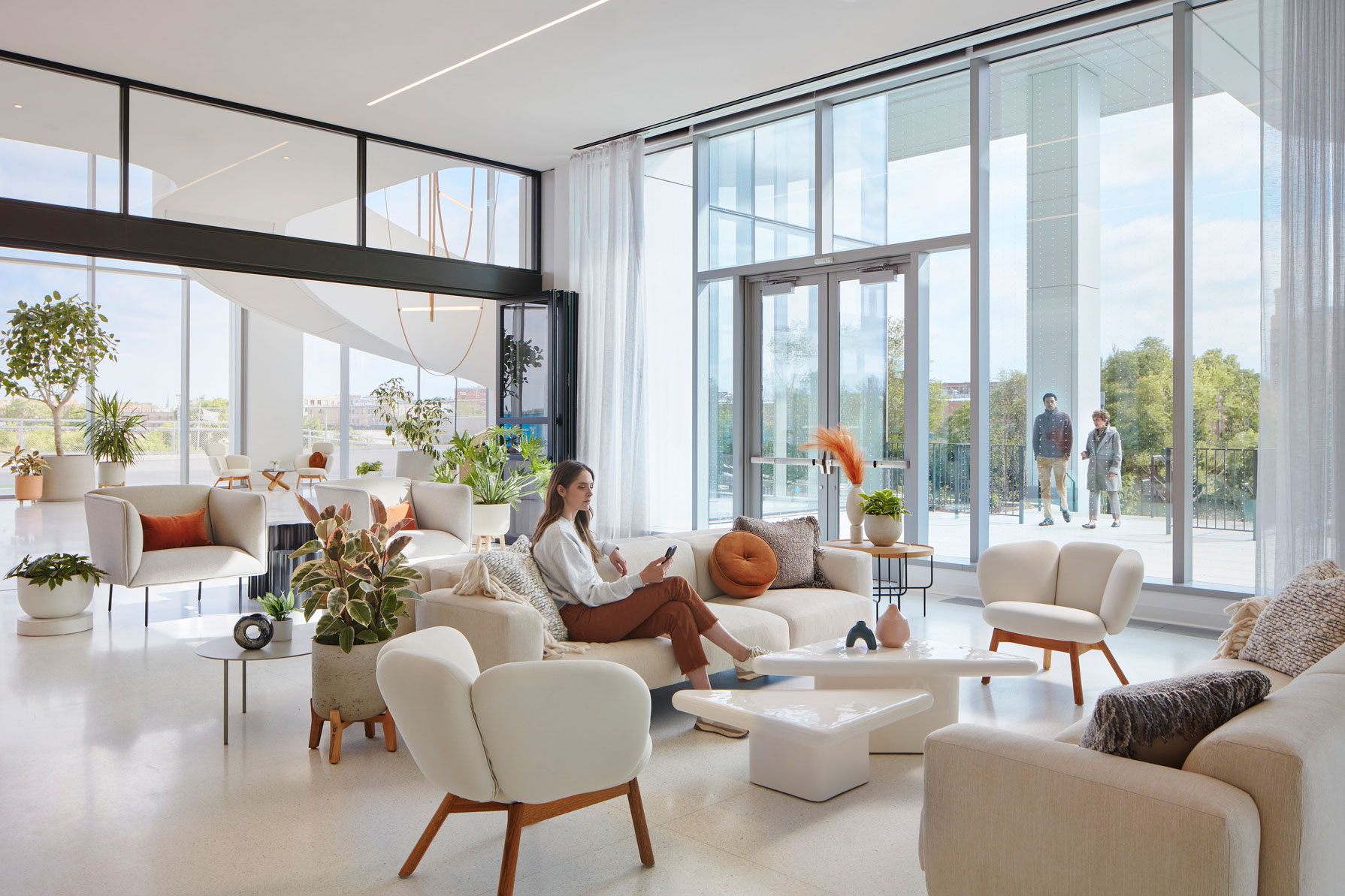
The interior design of 1229 W Concord feels warm and inviting—more hotel or living room than life sciences building. Photo by Kendall McCaugherty
A lot of the design centered on pairing the unexpected—combining the comforts of home with the sterileness of life sciences. In the ceiling, a metal panel has acoustical benefits and provides beauty and a feeling of calm comfort, while the white and wooden staircase brings people together.
“It appears as a visually continuous ceiling, but it also helps absorb sound. Then, when you go up the stairs, you suddenly have an exposed ceiling. That’s so different because it slides right into this really beautiful, perforated, off-white ceiling panel,” Mukoyama says.
Wood stairs carry you up the stark white staircase. “That ribbon of wood on the inside of the stair becomes the foundation of flooring, to the second level of the amenity area, which is where we have smaller breakout conference rooms and communal tables. That encourages people to have those opening meetings and still to gather and congregate together in a different way,” she says.
Setting Expectations
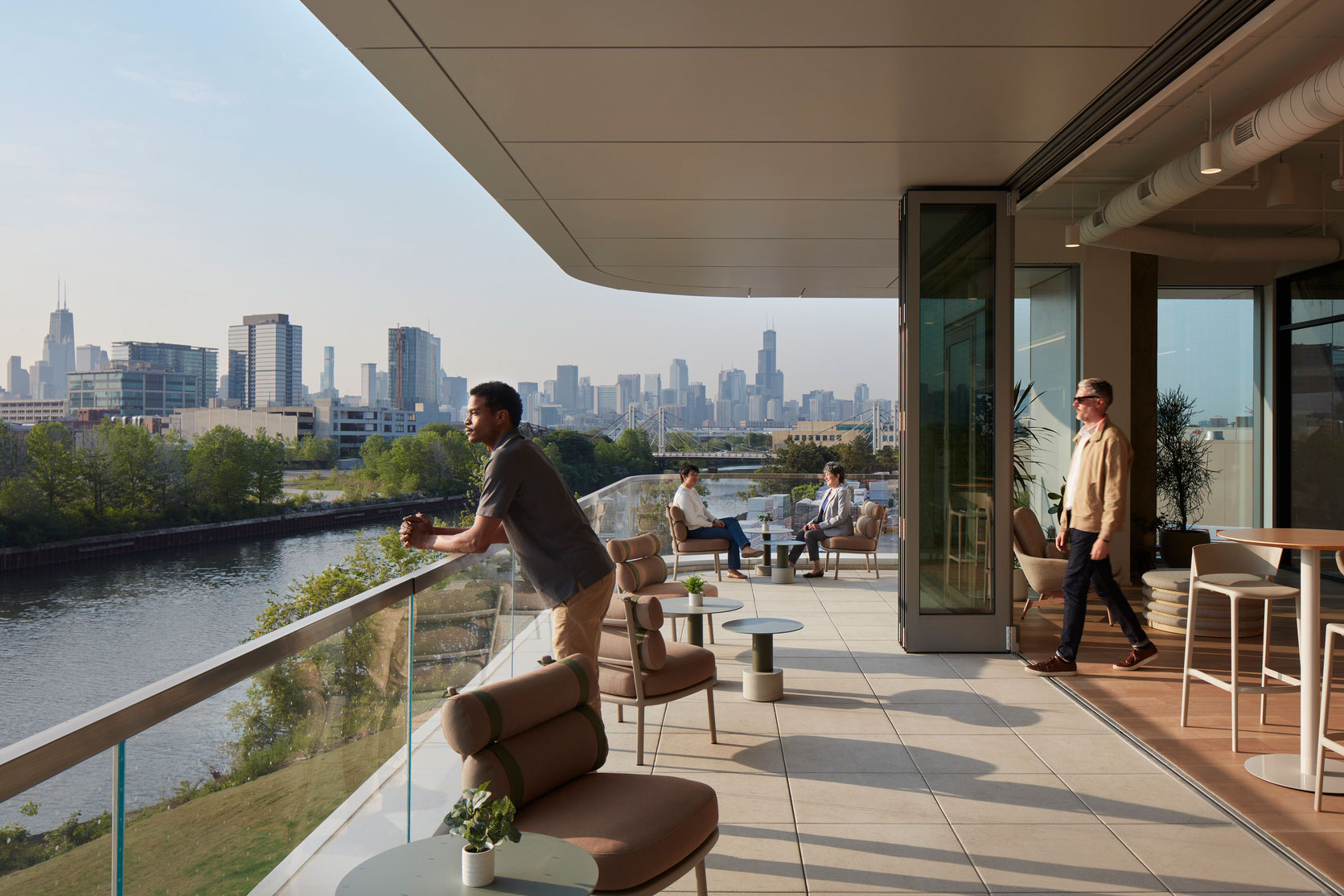
The Gensler-designed 1229 W Concord building in Chicago builds upon the health and well-being principles established in early 20th century modernism—natural light, openness, and access to the outdoors—principles brought about by the tuberculosis pandemic. Photo by Kendall McCaugherty
From the beginning the design team and Sterling Bay wanted to set the expectation that people who work in this building want to take part in an outdoor lifestyle. They want to be connected to a broader Riverwalk experience that will ultimately travel through Lincoln Yards. “Putting the amenities on the ground level and the main conferencing space on level two with outdoor terraces was very intentional,” Townsend says.
Mukoyama says the design continues to reveal people’s desire for outdoor space as part of their daily work lifestyle. People demand access to nature, and they want spaces that feel more like home. You’ll find a beautiful fitness center on the ground floor, and the staircase is highly visible, encouraging people to walk to and from building amenities. “That already changes your mentality of what you’re walking up to.”
The stair itself is prefabricated in three steel sections, designed and engineered to be self-supported. “It’s a really beautiful art piece and a nod to the ingenuity and the thinking behind life sciences,” Mukoyama says.
Plants, too, are unexpected in a life sciences building, as such spaces are required to be more sterile due to contaminant concerns. “Since we created such a generous amenity and community space on the ground floor and on the second, we wanted to bring that to light.” They used the public area as an opportunity for biophilic design. “In the actual lab area you wouldn’t be able to do that, but in a lobby environment you can, so you get both experiences in this building.”
Design for the Birds
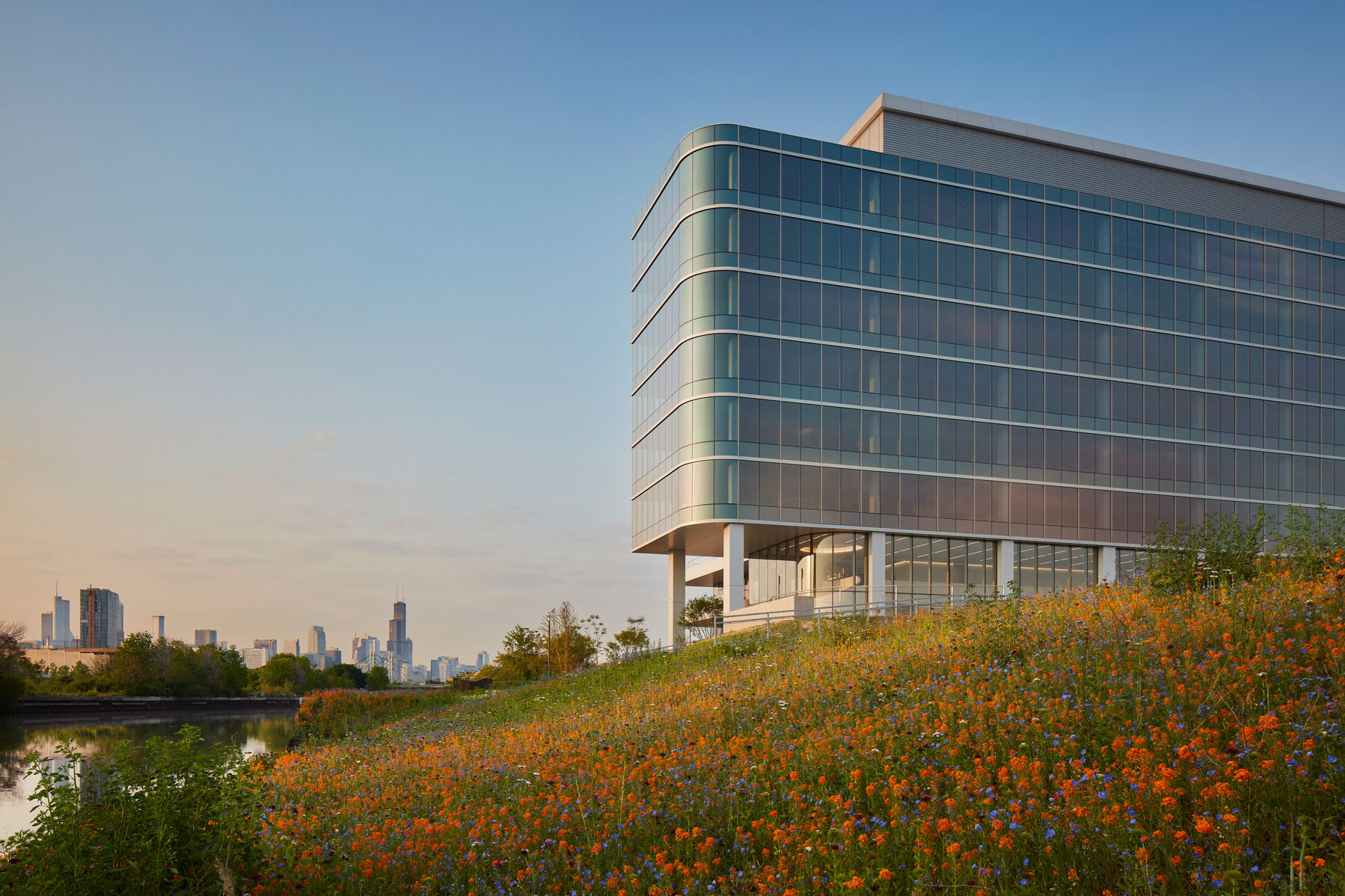
Lincoln Yards’ first major project, 1229 W Concord, is a life sciences building that overlooks the Chicago River. It was completed in 2023. Photo by Kendall McCaugherty
The building’s position along a migratory path meant considering serious bird-friendly strategies, too. Ultimately several levels of the building’s exterior glazing were outfitted with a subtle stencil pattern to avert bird collisions, protecting hundreds of species annually. It’s an expectation of all buildings at Lincoln Yards now, Townsend says.
“Chicago’s one of the most heavily trafficked migratory paths on Earth, particularly in the United States. We have a particular problem here in Chicago with this. This building has a number of ways that it is helping to minimize those collisions,” he says.
The typical glazing in the tower is an insulated glass unit with the Solarban 90 low-e coating and a 0.23 solar heat gain coefficient. A silkscreened quarter-inch dot spaced two-by-four inches helps make the glass more visible to birds. The exterior reflectance of the unit is also only 12%, which Townsend says is very low compared to many modern buildings in Chicago. “This helps limit the reflectance of the sky in the glass, which can also disorient birds.”
Lighting can also interfere with birds’ navigation systems. “That’s one of the reasons many buildings in Chicago turn off their lights after a certain period of time,” Townsend says.
As part of Sterling Bay’s efforts to further establish the life sciences community in Chicago, 1229 W Concord plays a key role in this first phase of developing the heart of Lincoln Yards. While the state-of-the-art building is designed to be a home for innovation, it also sets a precedent for design that is both science- and people-friendly, as the project takes cues from hospitality at every turn.
“It was a very purposeful blending of maybe what you would expect in a more warm, hospitable environment, almost like your living room or a hotel or any other hospitality-based environment,” Townsend says. “Scientists are people, too. All the things we think are so valuable to the human experience are also valuable in a lab environment.”
Project Details
Project: 1229 W Concord
Location: Chicago
Completion: 2023
Size: 285,000 square feet
Architect: Gensler
Developer: Sterling Bay
General Contractor: Power Construction
Carpet: Tarkett
Terrazzo: Menconi Terrazzo
Lighting: Anne Kustner Lighting Design
Landscape Design: Site Design Group
Awards: Pursuing LEED Silver, WELL Health-Safety Certification, and the RESET Air Standard
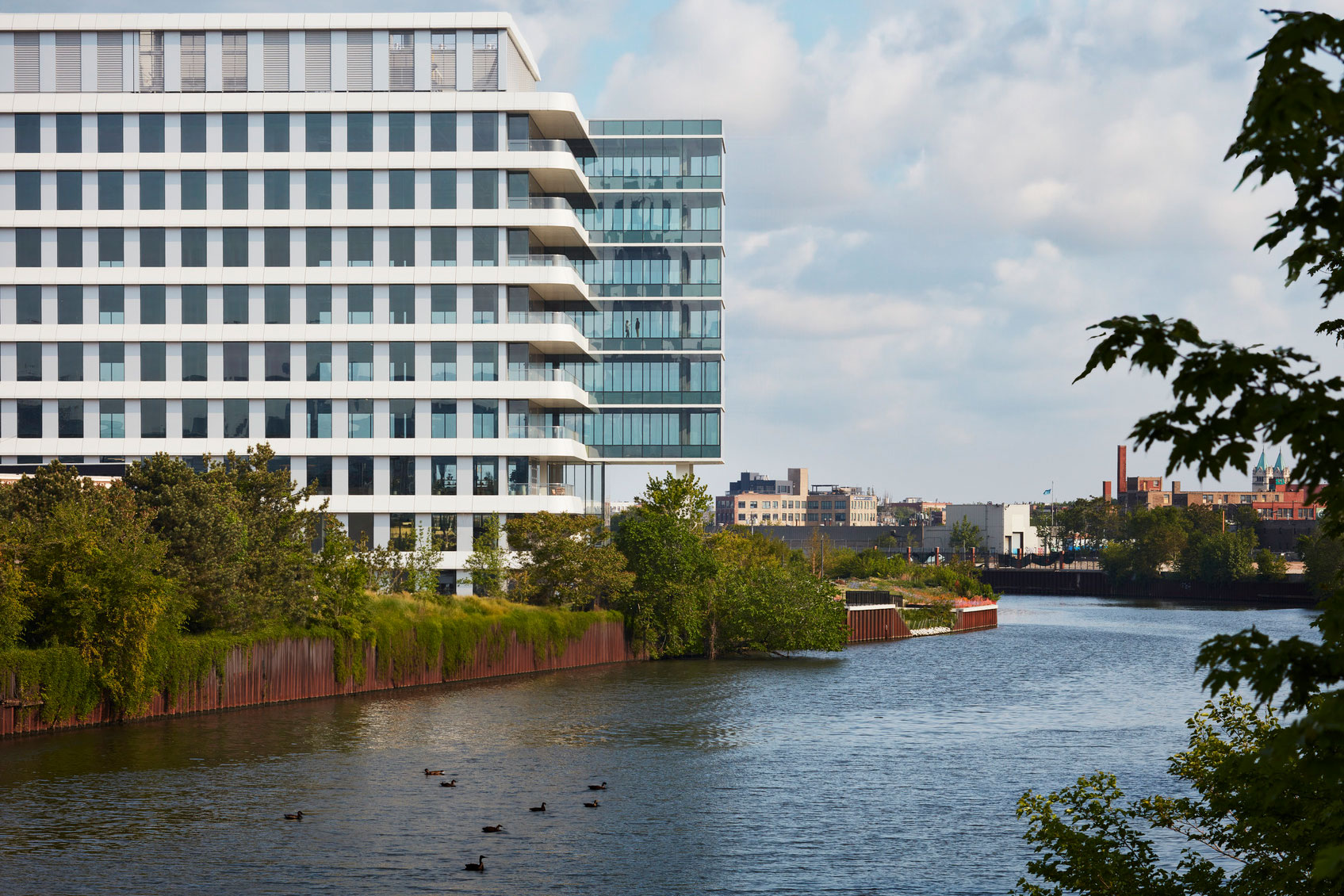
A special frit on the glass that helps prevent bird collisions is part of Gensler’s design at the riverfront 1229 W Concord life sciences building in Chicago. Photo by Kendall McCaugherty

A high-performing facade and low-VOC materials round out the building’s design. “Everything we’re seeing architecturally is also a beautiful mix of sustainable materials,” Mukoyama says. Photo by Kendall McCaugherty

